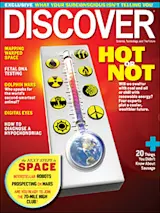Early one clear, still morning this past May, I slipped out of the funky old hot-springs town of Truth or Consequences, New Mexico, and headed southeast into the high desert. As a reddish sky gave way to sunrise over the San Andres Mountains, I crossed a stretch of arid wilderness so harsh and unforgiving that 17th-century Spanish explorers called it the Jornada del Muerto: the Journey of the Dead Man. The bumpy country road wound deeper into the scrubland until at last an undulating shape appeared in the distance. As I got closer, I could see it was in fact a hangar, shaped a bit like a giant crab, built into a berm. Just beyond it, a tabletop-flat slab of concrete runway stretched for two miles. There, on an arid patch of land surrounded by ancient mesas, was my destination: Spaceport America, the world’s first complex built solely for commercial ...
Out of the Blue, Into the Black
Commercial space travel is now almost within reach of ordinary citizens. But can small-a astronauts handle the ride?

Newsletter
Sign up for our email newsletter for the latest science news
More on Discover
Stay Curious
SubscribeTo The Magazine
Save up to 40% off the cover price when you subscribe to Discover magazine.
Subscribe













